|
|
|
|
|
|
|
|
|
|
|
|
|
|
|
|
|
|
|
|
|
|
|
|
|
Machu Picchu - Lost Inca City
...text by Larry Andersen, principle photography by Jeri L. Tubbs
|
|
|
|
|
|
|
|
|
|

|
|
|
|
|
|
|
|
|
Lost cities in he darkest jungles of South America! The very thought is the stuff that makes adventure movies. Thinking of ancient stone cities covered with dust and the debris of time congers up images of Indiana Jones with his bullwhip in hand. Alas! Indiana Jones is fiction. However, the discovery of Machu Picchu is somewhat more prosaic. It was discovered by accident while the archeologist was searching for two other lost Inca cities.
IN 1911 Hiram Bingham was following the Urabamba River into the mountains looking for the final stronghold, Vilcabamba, of Tupac Amaru the last of the Inca kings. While camped in the valley below the vine enshrouded Machu Picchu, a local farmer told him of the ancient city high up on the mountain top. The rest of Bingham's party did not want to scale the steep mountain and search for the ruins. Bingham, with a Peruvian soldier for company, followed the farmer up the steep vine and tree covered slope. Emerging from the tree cover at the top of the mountain, they encountered another farmer who was using the ancient Inca terraces for his own farm. There before Bingham was the magnificent and virtually forgotten (to the outside world) city of Machu Picchu.
Today modern railroad and bus transportation take you to the partially restored city. The intrepid visitor can hike the old Inca trail up the steep mountain and enter the city through the Sun Gate; and arduous five-day trek. The lucky visitor will have secured a room at the small hotel adjacent to the ruins. However one chooses to visit the ancient city, it will be remembered as one of the greatest of life's adventures.
|
|
|
|
|
|
|
|
|
|
|
|
Thirty thousand years ago, during the last ice age, Asiatic nomads wandered across the Bering land bridge and occupied a new continent. In the years that followed, the hardy band of newcomers multiplied and migrated to all of the far-flung corners of the new world. The arctic, the deserts, the great plans, mountain valleys, tropical rain forests and alpine tundra were all niches where these early nomads eked out a living. Many of these bands lived simply as hunter-gatherers letting the land and the sea provide for them. Some of these peo
|
|
|
|
|
|
|
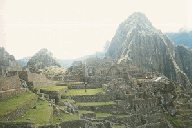
|
|
|
|
|
|
|
|
|
|
|
|
|
View of Machu Picchu showing the Sacred Plaza. In the background can be seen the peak of Huanna Picchu. Machu Picchu, at 8,000 feet, is nestled in the saddle of surrounding spires eighteen hundred feet above the Urubamba River valley.
|
|
|
|
|
|
|
|
|
|
|
|
|
|
|
|
|
|
ples developed complex societies which allowed them to develop and fully exploit the resources at hand. One such complex society was the Tahuantinsuyu. we have come to know them as the Incas.
Before the emergence of the Incas, many societies developed and then seemed to vanish. The resources used by these early societies were often fragile and easily over exploited. The western coast of South America has many unique features that have influenced the development of those ancient civilizations. Deep fertile seas abutting trackless desert shores, narrow and arid mountain valleys and high snow-covered mountains are familiar features of the area. From the deep offshore ocean basins to the tops of the Andes Mountains, there is an elevation change of forty thousand feet in little over one hundred surface miles.
|
|
|
|
|
|
|
|
|
|
|
|
|
Along the shore, the Atacama Desert is one of the driest deserts known. It is so dry that plants have evolved that rely on the moisture from the ocean fog. The desert is broken only by narrow bands of vegetation bordering the infrequent rivers that drain the western side of the Andes Mountains. The mountain valleys are precipitous and narrow. Arable land is scarce. Looking at the conditions, one would not expect a sophisticated culture to develop. And yet many cultures developed and then withered away as their ecological niches crashed. The Inca
|
|
|
|
|
|
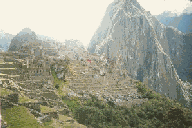
|
|
|
|
|
|
|
|
|
|
|
|
View of Machu Picchu showing the agricultural terraces that surround the city. When Hiram Bingham first climbed the steep mountainside to discover Machu Picchu, there was a farmer already there using the almost five hundred year-old Inca terraces for his own garden. The farmer then lead the discoverer to the rest of the overgrown ruins of the lost city.
|
|
|
|
|
|
|
|
|
|
|
|
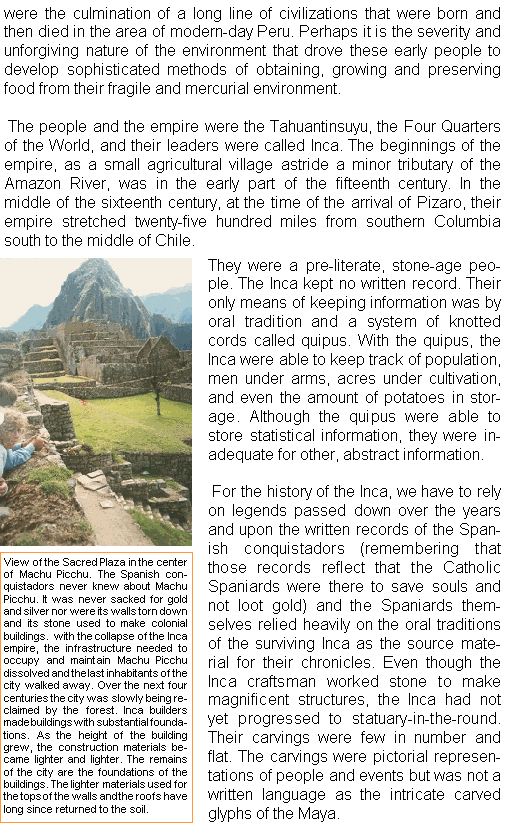
|
|
|
|
|
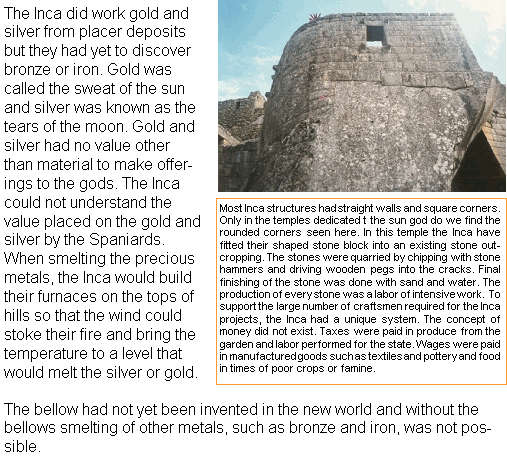
|
|
|
|
|
|
|
|
|
|
The Inca had no written record. Their history was an oral tradition. Today the descendants of the Inca have no memory of Machu Picchu. without a written record and without an oral tradition, we know virtually nothing about Mach Picchu except that it exists. We do not know the purpose of the city, we do not know when it was built nor do we know how
|
|
|
|
|
|
|
|
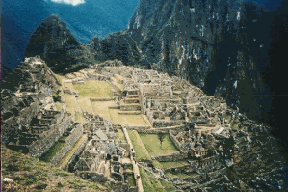
|
|
|
|
|
|
|
|
|
|
|
|
|
|
Overview of Machu Picchu. This view is from the trail leading to the Sun Gate. In the background can be seen the base of the spire named Huana Picchu.
|
|
|
|
|
|
|
|
|
|
|
|
|
|
|
|
|
|
|
long it was occupied. We can only infer answers from the artifacts. The Inca hid the existence of Machu Picchu from the Spaniards. There is no mention of Machu Picchu in any of the Spanish writings of the period. The secret of Machu Picchu was so well kept that, with the exception of a few isolated farmers, even knowledge of its ruins almost slipped from memory of the Inca's descendants.
The Inca did not use currency. The leaders collected taxes in the form of labor from the people. To pay the taxes, the people would serve in the army, quarry stone, provide agricultural goods to the leaders and the gods, erect and maintain the buildings and the extensive network of roads that linked every part of the far-flung empire. Payment to the people was in the form of food, cloth and other manufactured goods, such as pottery. Part of the food stuff collected form the people was stored in caches along the road network. The food was preserved y an alternate freezing during the cold, high-altitude nights and drying in the sun during the day. In the caches, convenient to the road network, there was enough food stored to feed the Inca army on the move, provide food in time of crop failure and feed the people engaged in work for the empire and not able to grow food for themselves.
|
|
|
|
|
|
|
|
|
|
|
|
The Inca capitol, Cuzco, was a large city by the time of the arrival of the Spanish conquistadors. Large cities, however, were not the norm. The majority of the population was scattered in smaller villages and hamlets along the length of the Inca highways. Each village was a center for the exploitation of the farmland available in the area. The steep mountains and narrow valleys did not provide extensive farmlands; there were no great plains or savannas. Terracing, a familiar sight in many parts of the world to increase arable land, was a common practice in the Inca lands. The amount of labor required to construct the retaining walls,
|
|
|
|
|
|
|
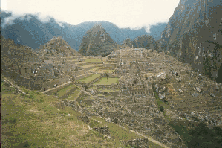
|
|
|
|
|
|
|
|
|
|
|
|
|
The saddle on the top of the mountain had little flat ground. The Inca craftsmen constructed walls and filled behind them to produce flat, open areas for plazas and gathering areas. There were storehouses, temples and living spaces within the city. It is estimated that the approximately fourteen acres of terraced land could not provide enough food to feed all the people the city was capable of housing. If Machu Picchu was occupied all of the time and not seasonally occupied, it would have been necessary to import food to feed all of the city's occupants.
|
|
|
|
|
|
|
|
|
|
|
|
|
|
|
|
|
|
filling the space behind with soil and then farming terraces provides some insight into the effective social organization of the Inca. Many of the Inca terraces have survived to this day and many are in daily use by farmers in the remote areas of the Andes.
|
|
|
|
|
|
|
|
|
|
|
|
|
|
The existence of Machu Picchu was unknown to the Spanish. None of the Spanish chroniclers describe Machu Picchu. We have no history, either written or oral, to tell us the reason for Machu Picchu Was it a fortress? The remoteness of the city and the easily defended avenues of approach would indicate the ruins were once a fortress. The construction, however, is not like any other Inca defensive structure. It does not have the typical concentric defensive walls, like Sacsahuaman fortress in the hills above Cuzco, that feature prominently in Inca citadels.
|
|
|
|
|
|
|
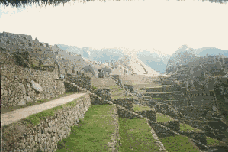
|
|
|
|
|
|
|
|
|
|
|
|
|
Close-up of the terraces and the stairway that seems to divide the city area in two. One can gain an appreciation of the labor intensive tasks required to fit the many, many different-sized and shaped stones together. The area is extensively terraced to make maximum use of the uneven land in the mountain saddle. There are many buildings including temples, storehouses, workshops and living quarters.
|
|
|
|
|
|
|
|
|
|
|
|
|
|
|
|
|
|
|
|
It has been estimated that the arable land within the terraces was insufficient to provide enough food to sustain the population if Machu Picchu was occupied year-round. Was the city then populated by a caretaker staff and only occupied at different times of the year either as a retreat for the king or perhaps for religious ceremonies? The purpose of Machu Picchu has
|
|
|
|
|
|
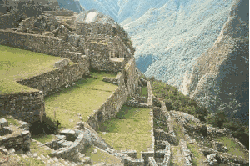
|
|
|
|
|
|
|
|
|
|
|
|
The sloping ground of the mountain saddle give way abruptly to an almost vertical drop two thousand feet above the Urubamba River. A close-up of the terraces gives construction details and a view of the drop-off at the edge of the last terrace.
|
|
|
|
|
|
|
|
|
|
|
|
|
|
|
|
|
|
|
never been satisfactorily determined. It may never be discovered exactly what Machu Picchu was for. Nevertheless, we can admire the city. We can wonder at the ability of a stone-age people to quarry that stone and shape it to such close tolerances. w can wonder at a people that had no written language but could superbly manage all the business of a large empire.
|
|
|
|
|
|
|
|
|
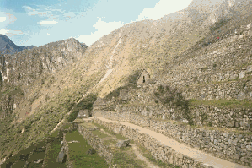
|
|
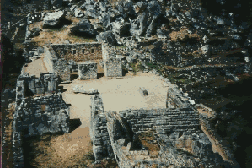
|
|
|
|
|
|
|
|
|
|
|
Additional view of the extensive terracing of the land on the edge of the city. In the background you can see shepherd cottages. Following this trail, you would arrive at the Sun Gate, the only overland access to Machu Picchu, along the ancient Inca highway.
|
|
|
|
|
|
|
|
|
|
|
|
|
|
|
A view of the Sacred Plaza and the Temple of the Three Windows (left center of the picture). The foundations of the buildings, made of stone have survived while the upper parts of the building, usually wooden material, have decayed and fallen. We can admire the Inca stonework.
|
|
|
|
|
|
|
|
|
|
|
|
|
|
|
|
Machu Picchu is the stuff of adventure movies, the lost city of an ancient civilization. No fabulous treasure has been uncovered but we are now able to se something of even greater value. We are able to see in these ruins, high on a mountain, the heights to which a people in a harsh, limiting and unforgiving environment can rise. The stone-age, pre-literate Inca people were able to build magnificent and lasting cities of closely hewn stone. They were able to create a mighty, far-flung empire and tied it all together with an extensive and remarkable system of roads. They created a unique economy based on labor and what labor produced. From the labor of the farmers, surplus crops were warehoused for times of famine. Before the Inca civilization's downfall at the hands of the Spanish conquistadors, the Inca empire encompasses over six million citizens. Their empire was connected by a network of ten thousand miles of high quality roads that amazed the Spaniards with its quality and engineering. The Inca were an advanced civilization and we are privileged to be able to see the ruins of one of their cities and wonder at the myriad accomplishments of the ancient Inca.
Principle photography by Jeri L. Tubbs. Text by Larry J. Andersen.
All rights reserved.
Additional material, sources as noted.
|
|
|
|
|
|
|
|










